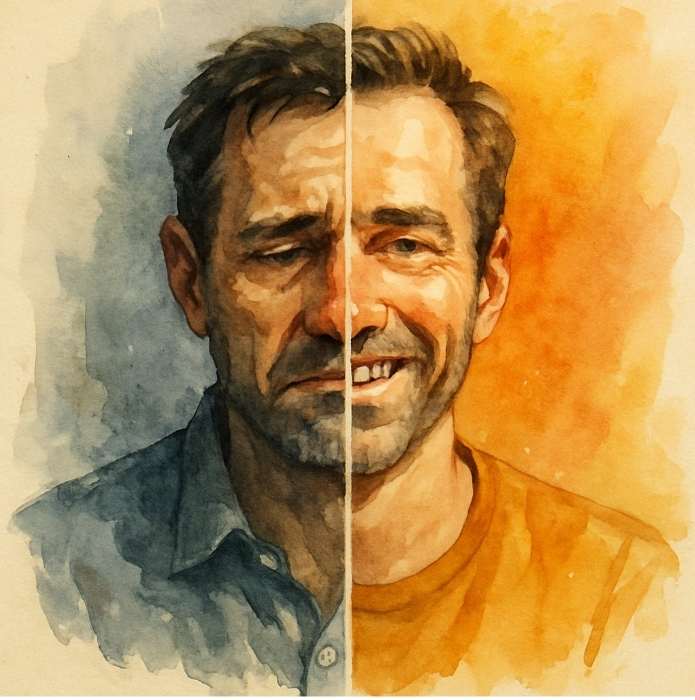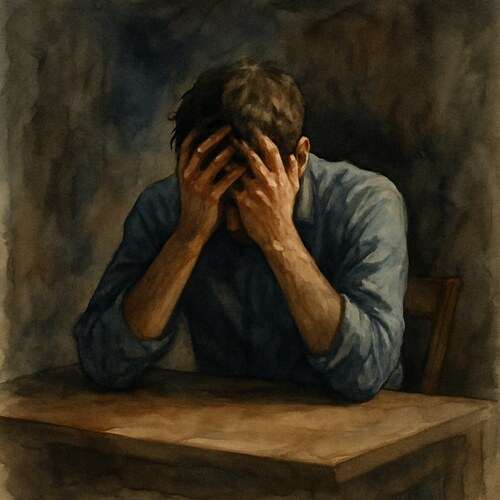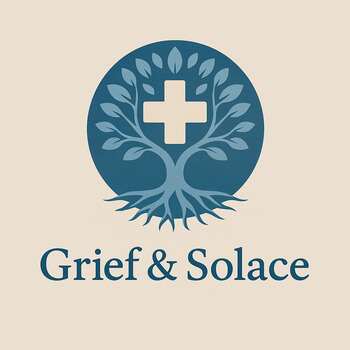Grieving Bipolar Disorder: Mourning the Person Lost Between Highs and Lows
Grief in bipolar disorder lives in the spaces between where the person you love disappears beneath the weight of mania or sinks too deep to reach.

This post blends real grief with grounded knowledge. It isn’t clinical. It isn’t distant. It’s meant to sit beside you—not above you. The story you’ll read is meant to reflect what so many feel when living through or witnessing this condition: confusion, exhaustion, and quiet forms of courage.
If what you read feels familiar, please speak with your doctor. Your pain deserves more than silence.
I Never Knew Which Version of Him Would Answer the Door
I never really knew who would come to the door. Sounds dramatic, right? But it’s true. I’d knock, and sometimes he’d greet me with those wild eyes, launching into a ten-minute monologue about his latest invention or some grand plan to change the internet forever. Other times, he’d pull me into a hug like I was a lifeline, desperate for comfort. Then there were the moments, lights on, car parked outside where he wouldn’t answer at all… Just silence.
🧠 Symptoms:
- Bipolar I Disorder:
At least one manic episode, possibly preceded or followed by hypomania or major depression - Manic episodes may involve psychosis (loss of touch with reality)
- Bipolar II Disorder:
At least one major depressive episode and one hypomanic episode - No full manic episodes
- Cyclothymia:
Ongoing (2+ years adults, 1+ year in children) swings between hypomanic and depressive symptoms - Less severe than full episodes but still disruptive
That silence? It cut deeper than the manic episodes. At least in those chaotic moments, I could reach him. Sure, he was all over the place—words tumbling out too fast, his body a whirlwind, ideas dancing on the edge of impossible, but he was there, in the chaos, dragging me into the storm as if it were a carnival ride.
If only I could forget how it always ended: burned out, hollowed, vanished…
Then came the crashes. The “I’m worthless” texts. Those late-night messages that just said, “Sorry.” I’d bring coffee, only to find a version of him that wasn’t merely tired but utterly erased. It was like someone wiped away the vibrant chaos of his manic self. He’d sit there, as if gravity were a weight too heavy to bear, staring through the walls, answering only when I asked twice.
I learned long ago to stop saying “Cheer up.” That’s what people miss, Bipolar isn’t just mood swings; it’s the slow erosion of identity, it’s watching someone you care about turn into a stranger, time and time again, and pretending you’re not terrified each time you witness it.
Complications:
- Substance use disorders
- Legal, financial, or relational issues
- Academic and workplace difficulties
- Suicide or suicide attempts
- Coexisting disorders: ADHD, PTSD, eating disorders, anxiety, borderline traits
- Physical health issues: Obesity, thyroid problems, migraines
Causes:
- Biological changes: Brain structure and chemical imbalances
- Genetics: More common with family history of bipolar disorder
- Trauma and stress: Triggers episodes or onset
- Risk Factors:
Having a first-degree relative with bipolar disorder - High-stress events or trauma
- Drug or alcohol misuse
One night, he painted for fourteen hours straight. No food, no blinking. When I showed up the next morning, canvases were sprawled everywhere! The floor, counters, and even the damn bathtub.
He looked at them and said, “They’re shit,” before starting to tear them apart. I tried to intervene, to save what he no longer valued, and he screamed…not at me, but as if I’d violated something sacred by daring to stop him.
There were moments when I hated him. Not in the way you think. More like the way you hate grief, how you resent that no one prepares you to hold onto someone who keeps slipping away. I hated how fiercely I loved him when he was at his most brilliant, how I missed him when he was just six feet away, completely silent.
The meds? They didn’t really fix anything. All they really did was soften the highs and lows and took the sharpness out of everything, but they never really brought “him” back; just made him slower, and quieter.
He once said, “It’s like trading brilliance for boredom, but hey, at least I’m alive.” And he truly meant it. God…he really did.
He’s still here, not healed, not fixed, just here. Some days, I catch a glimpse of that spark and brace myself for the fire. Other days, I sit next to him, reminding him that silence doesn’t equal failure…it’s just a pause. Each time I knock, I still wonder which version of him will greet me.
Additional Info:
- Mixed episodes: Depression and mania/hypomania symptoms at the same time
- Rapid cycling: Four or more mood episodes in one year
- Psychosis: Possible during severe mania or depression
- Symptoms may worsen during pregnancy or change with seasons
- Mania & Hypomania (shared features, differing severity):
Increased energy, agitation, or activity - Inflated self-esteem or grandiosity
- Decreased need for sleep
- Unusual talkativeness
- Racing thoughts, distractibility
Risk Factors (e.g., reckless spending, sexual risks):
- Major Depressive Episodes:
Persistent sadness, emptiness, or irritability - Loss of interest in most activities
- Significant weight change or appetite shift
- Sleeping too much or too little
- Fatigue or slowed physical activity
- Feelings of worthlessness or guilt
- Trouble concentrating or making decisions
- Thoughts of death, suicide, or attempts
You don’t grieve bipolar all at once. You grieve it in cycles—manic, muted, and everything in between.
📘 Diagnosis & Treatment
Diagnosis:
Physical exam and lab tests: Rule out medical causes
Mental health evaluation: Includes interviews, mood charting, and input from loved ones
DSM-5 criteria: Used to classify the type and frequency of mood episodes
Children and teens: Diagnosed with same criteria, but symptoms may present differently and be confused with ADHD or behavior issues
Treatments:
- Medications:
Mood stabilizers: Lithium, valproic acid, carbamazepine, lamotrigine - Antipsychotics: Olanzapine, risperidone, quetiapine, aripiprazole, ziprasidone, lurasidone, cariprazine
- Antidepressants (used cautiously, with stabilizers): May trigger mania
- Combination drugs: Symbyax (fluoxetine + olanzapine)
- Anti-anxiety medications: Short-term use, e.g., benzodiazepines
- Note: Medication adjustments require patience—finding the right mix takes time. Many require blood monitoring and ongoing evaluation.
Psychotherapy:
- Cognitive Behavioral Therapy (CBT): Identifies negative thought cycles and coping strategies
- Interpersonal and Social Rhythm Therapy: Regulates sleep, meals, and daily rhythms
- Psychoeducation: Helps patients and families recognize warning signs
- Family-focused therapy: Builds support, improves communication
Other Treatments:
- Electroconvulsive therapy (ECT): For treatment-resistant or severe episodes
- Repetitive transcranial magnetic stimulation (rTMS): Emerging option for depression
- Ketamine: Short-term relief for treatment-resistant depression (still under study)
Children & Teens:
Treated with carefully adjusted medications and long-term therapy
- Includes school support and family involvement
- Lifestyle Recommendations:
Medication adherence: Crucial to prevent relapse - Sleep regulation: Disrupted sleep can trigger episodes
- Avoiding drugs/alcohol: Reduces relapse risk
- Monitoring early warning signs: Helps prevent full-blown episodes
I know this is heavy, and I understand that the road ahead may feel like a tangle of loss and unanswered questions. But please hear this: you are not broken because you are hurting; you are not weak because you are afraid. You are living through something real, and survival itself is a kind of grace. You are allowed to struggle, you are allowed to hope, and you are allowed to not have all the answers today. Whatever comes next, you do not face it empty-handed; you carry every moment of love that shaped you, and that will always be enough to keep going.
🎀 Gifts to help With Bipolar Disorder
🏥 Everyday Comforts for Everyday Battles
Managing Bipolar Disorder often means needing a little extra help.
Sometimes it’s about restoring dignity, ease, or simply getting through the day with less pain.
These carefully chosen tools aren’t just items; they’re small bridges back to living.
This section is about finding practical support never shame.
Sunrise Wake-Up Light – Gentle Structure When Days Blur and Nights Won’t End
When bipolar episodes hit, time collapses. Sleep becomes chaos—too much during depressive phases, not enough during mania. This sunrise-simulating alarm clock helps restore circadian rhythm without the jarring buzz of a traditional alarm. It eases you into morning with gradual light, mimicking nature’s rhythm even when your internal one’s gone rogue. For those who crave routine—but can’t always keep it.
🌿 Paths to Healing Beyond the Map
Sometimes traditional medicine isn’t enough.
If you’re exploring gentle, alternative options to help with Bipolar Disorder,
you might find comfort in plant-based compounds like **CBD or CBG**.
*This section is not medical advice just a door left open.*
USA Medical Broad-Spectrum CBD Oil – Stabilizing Calm When Emotions Spiral
Bipolar disorder can feel like being pulled between lives, manic highs that light you up, followed by depressive crashes that hollow you out. This THC-free CBD oil is designed to help ease the nervous system into balance. No highs, no fog—just a subtle sense of grounding. It’s not a cure. But on days when your mind’s on fire or falling, it might help slow the descent.
Need a Different Path Forward?
Every journey through grief looks different. Choose the next step that speaks to where you are now:
When You're Ready to Start Healing
Healing doesn’t mean forgetting.
It means finding small ways to carry your grief with strength and grace.
These are the stories, tools, and gentle steps to begin walking forward…at your own pace.
When You're Still in the Thick of It
Sometimes healing feels like a lie.
If you’re not ready to move on…if the pain still roars louder than the world wants to hear…this is the place where you’re allowed to feel it.
No sugarcoating. No pretending. Just truth.
When You're Holding on to Who’s Still Here
Grief reminds us to love louder.
If someone you love is still with you, this is your place to celebrate them, honor them, and create new memories while there’s still time.
Joy and sorrow can live side by side.






